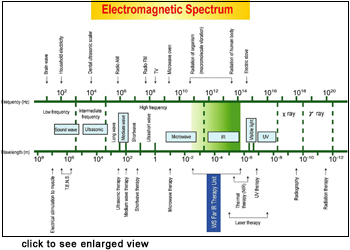 In the electromagnetic spectrum, Ultraviolet (UV) and infrared (IR) are both invisible rays that exist on opposite sides of the visible light. UV is known to initiate the photochemical reaction with DNA and RNA, often used for sterilization and disinfection purposes. IR produces thermal therapeutic effects that are often used for clinical rehabilitation and treatment. In the electromagnetic spectrum, Ultraviolet (UV) and infrared (IR) are both invisible rays that exist on opposite sides of the visible light. UV is known to initiate the photochemical reaction with DNA and RNA, often used for sterilization and disinfection purposes. IR produces thermal therapeutic effects that are often used for clinical rehabilitation and treatment.
 Far-Infrared Far-Infrared
According to the difference in wavelengths, IR could be roughly divided into Near-Infrared (NIR, 0.75~3Ám) and Far-Infrared (FIR, 3~1000Ám); the difference in wavelengths also contributes to the significant difference in their properties. Due to its higher frequency, NIR has higher power density and generates more heat, thus often used for quick drying and high-temperature firing. On the other hand, FIR has lower power density and generates less heat, though its penetrability is weaker, it is more readily absorbed by the human body.
 Low power density Low power density
The electromagnetic energy of FIR is distributed between a wide spectrum from 3Ám to 25Ám with peak value among 5Ám and 7Ám. Despite its remarkable therapeutic effects, the power density of FIR is only at milliwatt level and its energy grade is far below that of the ordinary Infrared (Near-Infrared).
 Energy transfer with resonance Energy transfer with resonance
When FIR irradiates the human body, some are reflected and the rest are fully absorbed by the skin. Due to the similarity in wavelengths between FIR and that of water and protein, the energy from the irradiation initiates energy resonance within the tissues that enhances further energy absorption, which results in an increase in topical temperature.
 Thermal and non-thermal effects Thermal and non-thermal effects
The physical responses induced by the topical temperature elevation following FIR irradiation are described as thermal effect. However, FIR is believed to initiate more than just thermal effect. There are some consequential responses observed in FIR clinical application and animal studies that cannot be explained or comprehended by thermal effect alone, including the FIR energy transfer mechanism in the tissue level, and these processes are described as non-thermal effect. The fascinating nature of FIR has remained the hot topic for researchers in recent years.
|







